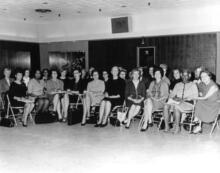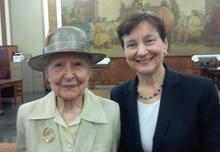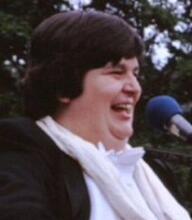Bernice Sandler
Bernice (Bunny) Sandler was an education expert whose feminist activism led to the passage of Title IX of the Education Amendments Act of 1972, the federal policy that mandates sex equality in educational institutions that receive federal funding. Sandler had initially researched the legality of sex discrimination in education after being denied an academic job in the late 1960s, and she worked with U.S legislators to create the framework for Title IX. After the passage and implementation of Title IX, she continued her groundbreaking work on issues of gender, sex, racial, and ethnic equality. Sandler theorized the concepts of “chilly climate” and “gang rape” to frame these problems as structural discriminations toward women.
Early Life and Education
Bernice Resnick was born in Brooklyn, New York, on March 3, 1928, to Russian and German Jewish immigrants; Bunny, her lifelong nickname, was derived from the Yiddish translation of her given name. Her parents, Abraham Hyman Resnick and Ida (Ernst) Resnick, owned a women’s clothing store in Rockaway, New Jersey. They raised Bunny and her older sister Rhoda in Brooklyn, urging the children to embrace social justice along with their Jewish faith. Unlike many young women of the World War II era, she graduated from high school at age sixteen and immediately pursued higher education. She earned a bachelor’s degree, graduating magna cum laude from Brooklyn College as a psychology major in 1948, and took a master’s degree in clinical psychology at City College of New York two years later.
After graduating, Sandler sought an academic psychology position but faced anti-Semitic quotas in the programs where she applied. She then put her academic aspirations on hold for over a decade. During that time, she taught preschool, gave guitar lessons, and worked as a secretary. In 1952, she married public radio producer Jerrold Sandler, whom she divorced in 1978; they had two children, Deborah Jo and Emily Maud, in the mid-1950s. When her daughters reached their teen years, Sandler resumed her graduate education.
Professional Training and Feminist Turn
More than fifteen years after graduating from college, Sandler enrolled at the University of Maryland to pursue her doctorate in education. By all accounts excelling in the program, she graduated with her Ph.D. in counseling and personnel services in 1969. She then applied, at age 41, for one of multiple open faculty positions in the education department at Maryland. Sandler’s application was rejected, despite her stellar qualifications. In a turning point of her life, one of Sandler’s graduate professors confided that her sex had disqualified for the position: “…let’s face it,” he told her, “you come on too strong for a woman” (Sandler, 1997). She immediately remembered numerous times when she had been assertive in school and wondered whether she should regret that active participation in the life of the department. When her husband Jerrold suggested that sex discrimination accounted for her rejection, however, Sandler began to understand her treatment as part of a systemic segregation of women from men in education.
In her own telling, Sandler had never identified as a women’s equality activist. Indeed, she regarded the 1960s feminist movement as somewhat suspect, seeing its activists as “‘abrasive,’ ‘manhating,’ ‘radical,’ and unfeminine’” (Sandler, 1997). But her understanding of feminist activism changed in the following months, as more institutions used explicitly sexist rationales to deny her job applications. One man rejected her because she was a mother, assuming that her commitment to her children would make her an unreliable worker. Another denied her academic qualifications, telling her she was “just a housewife who went back to school” (Sandler, 1997). These collective incidents of rejection led her to believe that sex discrimination pervaded higher education to the detriment of women.
Title IX
After her experiences of academic rejection, Sandler set out to understand how colleges and universities had legally justified their biased treatment of qualified female candidates. She initially assumed these institutions were breaking an existing law. When she investigated, however, Sandler realized that numerous policy loopholes had historically allowed schools to discriminate based on sex. She set out to challenge these problematic policies in order to fight for sex quality in education.
Sandler began by looking to previous examples of activism that had catalyzed federal antidiscrimination policy. The post-World War II movement for racial justice was her starting point. Civil rights activists had taken to the streets in nonviolent protest for decades, but they had also lobbied Congress to push for the bill that became the Civil Rights Act of 1964. Yet while various sections of the Civil Rights Act—its titles—outlawed discrimination in certain contexts, none prohibited sex discrimination in education. For instance, while Title VI forbade discrimination in federal programs, it excluded sex at that time; Title VII outlawed employment discrimination based on race, color, national origin, sex, and religion but exempted education. The Equal Pay Act likewise fell short, omitting academic faculty because it did not cover administrative and professional workers.
After exhaustive research, Sandler found a policy she could pursue. In 1965 President Lyndon Johnson had written a directive—Executive Order 11246—that forbade federal contractors from employment discrimination in race, color, national origin, or religion. Sandler discovered in a footnote that Johnson had amended the order in 1968 to include sex. “Even though I was alone, I shrieked aloud with my discovery,” she recalled. “I had made the connection that since most universities and colleges had federal contracts they were forbidden from discriminating in employment on the basis of sex” (Sandler, 1997). With the support of Vincent Macaluso, director of Federal Contract Compliance at the Department of Labor, Sandler prepared a legal complaint against higher education institutions. She worked with the Women’s Equity Action League to file, in the Department of Labor, a massive class action complaint against American colleges and universities. She compiled an 80-page document with supporting evidence of sex discrimination in academia to send to members of Congress and media outlets, asking them to publicize the issue and pressure the Department of Labor to enforce the sex discrimination amendment to EO 11246. Introducing the public to unequal sex opportunity in education shifted the momentum toward change in the early 1970s.
Sandler’s class action complaint captured the attention of key allies in Congress who sympathized with victims of academic sex discrimination. In early 1970, congressmembers Martha Griffiths and Edith Green gave floor speeches and held hearings in the House of Representatives. Representative Patsy Mink—the first woman congressperson from Hawaii and the first Asian American woman elected to Congress—adapted Green’s early draft of an antidiscrimination law to write the bill that passed the House and moved to the Senate. Women legislators across race, ethnicity, and religion spoke in support. New York representative Shirley Chisholm, the first Black woman member of Congress, testified that sex had proven “…a far greater handicap than my skin pigmentation” (Kessler-Harris, 2003).
When the Title IX hearings ended, Green tapped Sandler to write a record of the proceedings in the U.S. House of Representatives Special Subcommittee on Education—making Sandler the first person to work on a women’s rights issue as a Congressional committee staffer. Her final product comprised almost 1,300 pages and was sent to every member of the U.S. Congress, along with news organizations and education leaders. Mink worked with U.S. Senator Birch Bayh to shepherd the bill through the Senate, where it received little attention and passed largely unopposed. In order to avoid affecting any previously protected categories in the Civil Rights Act, lawmakers passed Mink’s text as a new title—which became Title IX of the Education Amendments Act of 1972.
Expertise and Activism between 1970 and 2019
The fight for Title IX and its 1972 passage changed the trajectory of Sandler’s life, transforming her from an underemployed academic to a national expert on sex equality policy. Although Sandler had not anticipated the sweeping impact of the law across such disparate aspects of education as hiring, admissions, sport, and safety, she fought for its comprehensive implementation. As such, she faced resistance from administrators concerned about having to cut budgets in order to allocate funding to women. By the mid-1970s, collegiate athletic departments had become some of the most vociferous opponents of Title IX and tried, unsuccessfully, to exempt sports from coverage under the law. President Gerald Ford tapped Sandler to lead a new National Advisory Council on Women’s Educational Equity in 1975 and President Jimmy Carter reappointed her to the chair position, in which she wrote the first national reports on sexual misconduct in education and rural women’s education.
Sandler became a nationally renowned speaker on sex and gender equity during the 1980s, a period in which Reaganite conservatism threatened to constrain feminist gains. Journalists and politicians began describing the era as “postfeminist,” arguing that the need for sex equality activism had ended, given women’s increasing roles in public life. But Sandler countered this view. She produced groundbreaking research showing that campus and workplace inequities persisted, albeit in less obvious forms than a decade earlier. Among these inequities, Sandler argued, were the myriad barriers and aggressions that women faced on campus. She created the concept of the “chilly climate” to describe the compounded effect of these factors, which ranged from male students’ derision to sexist tenure evaluations. Sandler authored numerous works on chilly academic climates and how to eradicate them, becoming a sought-after strategist. She consulted on a plan for the Citadel, the historic southern men’s military college, to admit its first woman student in 1995. And as an adjunct associate professor at Drexel University College of Medicine, she challenged doctors’ use of texts and pedagogies that framed male bodies as normative and female physiologies as unworthy of sustained study save for their capacity as mothers. She also addressed the interlocking effects of racism and sexism, developing strategies in the 1980s and 1990s for dealing with the vitriol and structural disadvantages that Black and Latina women faced in academia.
Sandler also brought to light the sex disparities in campus sexual violence. Because rape and sexual harassment fell under the domain of Title IX (schools must provide equally safe environments for women and men), Sandler pioneered research on, and activism against, sexual violence cultures in K-12 and post-secondary schools alike. She revealed campus cultures of sexual assault, coined the term “gang rape,” and refused to downplay the trauma of peer violence; one section of her website on sexual assault was titled “Friends Raping Friends: Could it Happen to You?” Furthermore, she tracked faculty and staff sexual harassment rates and educated universities on how to stop discriminatory trauma cultures within their institutions—advocacy that presaged the Clery Act of 1990, which forced schools to report incidents of gender-based crimes to their campus communities and prospective students.
In the later years of her career, Sandler was a senior scholar at the Women’s Research and Education Institute in Washington, D.C. She was memorialized as the “godmother of Title IX” by media outlets in thousands of tributes after she succumbed to cancer at age 90 on January 5, 2019.
“Bernice R. Sandler, Ed.D.” Maryland Women’s Hall of Fame, via Maryland Commission for Women and Maryland State Archives, 2010. https://msa.maryland.gov/msa/educ/exhibits/womenshall/html/sandler.html
Chrisler, Joan C. and Maureen C. McHugh. “In Memoriam: Bernice Resnick Sandler (1928-2019).” American Psychologist Vol. 75, No. 1 (January 1, 2020), pp. 119-120.
DiSciullo, Issa. “Remembering Dr. Bernice ‘Bunny’ Sandler, the ‘Godmother of Title IX,’” Office of Diversity, Equity & Inclusion Blog, Drexel University College of Medicine, https://drexel.edu/medicine/about/diversity/diversity-blog/remembering-dr-bernice-sandler-godmother-of-title-ix/
Isard, Risa. “Title IX and ‘tikkun olam.” Jewish News Syndicate, February 8, 2019. https://www.jns.org/opinion/title-ix-and-tikkun-olam/
“Jerrold Sandler, Key Advocate for Public Radio Funding, Dies at 64”. Current, March 6, 1995. https://current.org/1995/03/jerrold-sandler-key-advocate-for-public-radio-funding-dies-at-64/
Kessler-Harris, Alice. In Pursuit of Equity: Women, Men, and the Quest for Economic Citizenship in 20th Century America. Oxford: Oxford University Press, 2003.
Lawrence, Brenda L. (MI). “Honoring the Life of Dr. Bernice (Bunny) Sandler.” Congressional Record 165:105 (June 21, 2019), p. E817. https://www.congress.gov/congressional-record/2019/06/21/extensions-of-remarks-section/article/E817-5
Macaulay, Alexander. Marching in Step: Masculinity, Citizenship, and The Citadel in Post-World War II America. Athens, GA: University of Georgia Press, 2009.
MacLean, Nancy. Freedom is Not Enough: The Opening of the American Work Place. Cambridge, MA: Harvard University Press, 2006.
“Memorial Addresses and other Tributes held in the House of Representatives and Senate of the United States Together with Memorial Services in Honor of Patsy T. Mink, Late a Representative from Hawaii.” Congressional Record (September 30, 2002). Washington: U.S. Government Printing Office, 2003, pp. 1-168. https://www.govinfo.gov/content/pkg/CPRT-107JPRT82489/pdf/CPRT-107JPRT82489.pdf
“Obituaries 3-3-95.” The Rock Island Dispatch-Argus, March 3, 1995. https://qconline.com/obituaries/obituaries-3-3-95/article_b78ce411-111e-5755-852d-0585f272a21d.html
Sandler, Bernice R. “‘Too Strong for a Woman’—The Five Words that Created Title IX.” About Women on Campus (National Association for Women in Education Newsletter), Spring 1997, pp. 23-28.
Sandler, Bernice R. “All About Bernice Sandler.” bernicesandler.com (Bernice Sandler’s inactive website), ca, 2001. Accessed March 20, 2021. https://web.archive.org/web/20180905180811fw_/http://www.bernicesandler.com/id32.htm
Sandler, Bernice Resnick, Lisa A. Silverberg, and Roberta M. Hall. The Chilly Classroom Climate: A Guide to Improve the Education of Women. Washington, DC: National Assn. for Women in Education, 1996.
Sandler, Bernice Resnick and Roberta Hall. “The Campus Climate Revisited: Chilly for Women Faculty, Administrators, and Graduate Students.” Project on the Status and Education of Women, Association of American Colleges, Washington, D.C. 1986. https://files.eric.ed.gov/fulltext/ED282462.pdf
Seelye, Katharine Q. “Bernice Sandler, ‘Godmother of Title IX,’ Dies at 90.” New York Times, January 8, 2019, p. B10. https://search-proquest-com.ezproxy.lib.umb.edu/docview/2164939728?pq-origsite=primo
Title IX of the Education Amendments of 1972, 20 U.S.C. D, 1681 – 1688. https://www.justice.gov/crt/title-ix-education-amendments-1972
Turk, Katherine. Equality on Trial: Gender and Rights in the Modern American Workplace. Philadelphia: University of Pennsylvania Press, 2016.
Ware, Susan. Game, Set, Match: Billie Jean King and the Revolution in Women’s Sports. Chapel Hill, NC: University of North Carolina Press, 2011.
Ware, Susan. Title IX: A Brief History with Documents. Long Grove, IL: Waveland Press, Inc., 2007.













